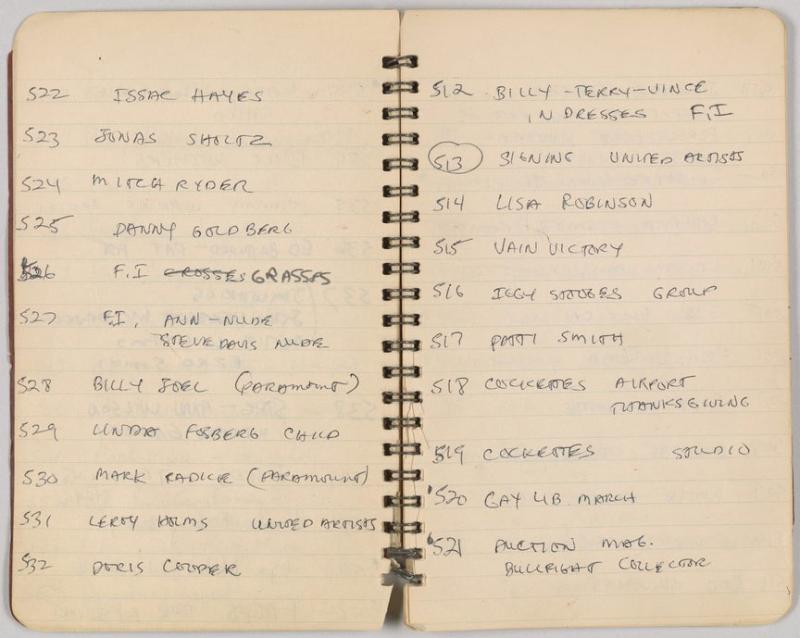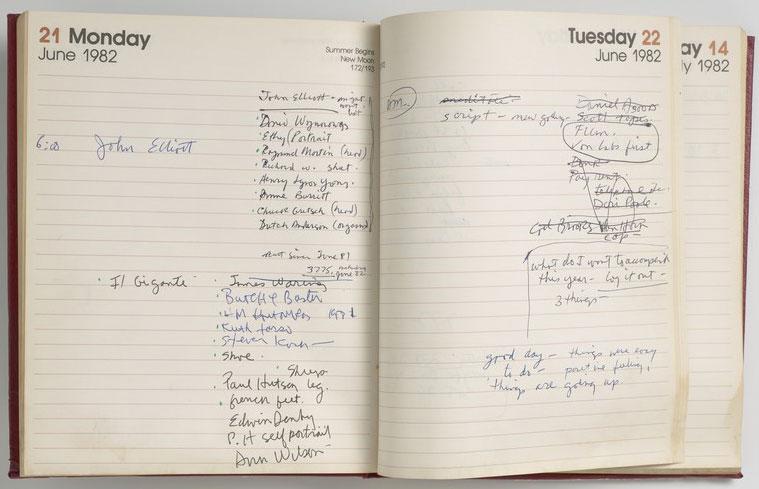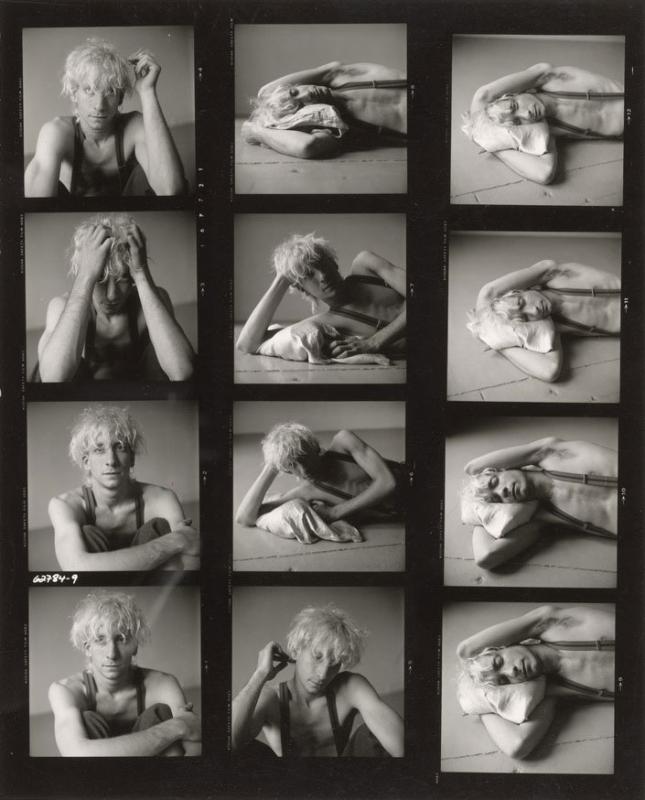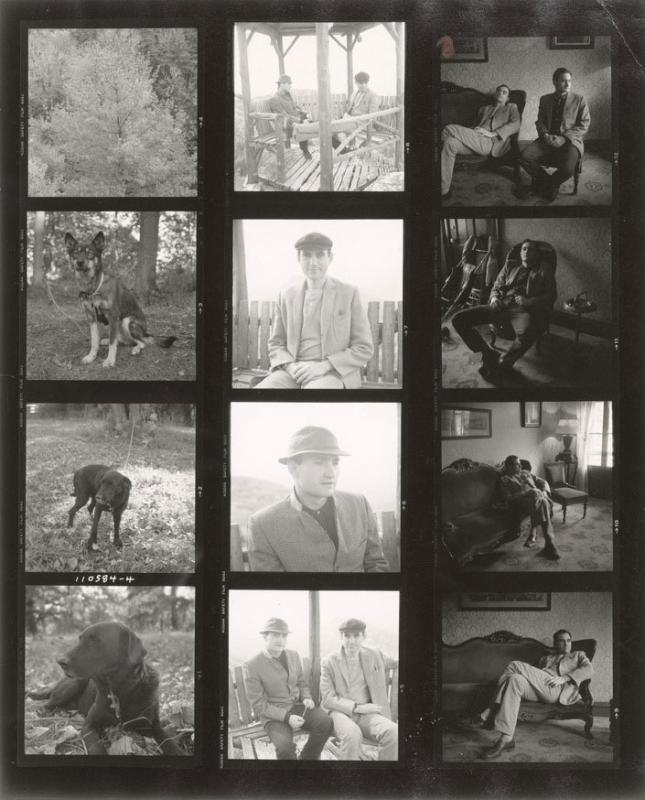
Peter Hujar, Peter Hujar Papers, 19??–1987, bulk 1950–1987, Box 21. Job Book, Neg. # 100–650, spread 522–521. 2013.108. The Morgan Library & Museum. © The Peter Hujar Archive / Artists Rights Society (ARS).
Ten years ago, the Morgan’s Department of Photography made a landmark acquisition: Peter Hujar’s papers, 100 photographic prints, and 5,783 black-and-white contact sheets. The contact sheets are of great importance: they span the artist’s career from 1955 until his death of AIDS-related pneumonia in 1987, and index nearly every black-and-white exposure that he made. These objects occupy a liminal space between archive and art object; they are process documents that gave Hujar his first glance at each frame on a roll of film. Many of them bear his editing marks, written in varying colors of oil pencil, that indicate a preferred frame or intended cropping of a print. Sometimes, one frame from the sheet has been cut out, perhaps to mail to the subject depicted, or to tack up on his own darkroom wall. Lending depth to Hujar’s oeuvre beyond the finished prints, his contact sheets are rich in narratives and lend tremendous insight into his creative process.
When I began the Edith Gowin Curatorial Fellowship in the fall of 2022, I immediately delved into the nine boxes full of Hujar’s contact sheets. My central project as a fellow has been work on a forthcoming exhibition of the contact sheets, a sequel to Peter Hujar: Speed of Life, the retrospective co-organized by the Morgan and Fundación MAPFRE, which toured 2017–2020. Though quickly enamored with the vast number of exposures I could see over the course of 32 years of Hujar’s photographic career, one challenge quickly made itself evident: until 1981, when Hujar’s friend and mentee Gary Schneider began to process his film, his shoots can rarely be dated with precision.
Hujar kept a record of his photographic work, though it was an abbreviated one. In what we refer to as his “job books”— two slim, spiral-bound notebooks—he wrote a number (beginning in 1955 at 100 and ending in 1986 at 1093) and brief identifier for each of his shoots. Most of the time, the identifier lists the name or names of the subject(s) depicted; sometimes, a location or event is also included. In the case of specific events, such as the April is Peace March (1967) or the performances of the Cockettes in New York (1973), dates could easily be assigned to the sheets depicting them. For most of the contact sheets, however, this wasn’t the case. Tasked with cataloging contact sheets as part of the process of creating the checklist for the forthcoming exhibition, I tried to date as many sheets as possible.

Peter Hujar, Peter Hujar Papers, 19??–1987, bulk 1950–1987, Box 22 (Appointment Books), open to pages 21-22, June 1982. 2013.108. The Morgan Library & Museum. © The Peter Hujar Archive / Artists Rights Society (ARS).
This work began in Hujar’s papers. Over the course of several appointments in the Morgan’s Sherman Fairchild Reading Room, I made my way through the many boxes of his correspondence, publications, business records, and personal papers. I read through all written material closely and took note of any dates that appeared. Even though these dates were assigned to finished prints, either in a publication clipping or a handwritten receipt of sale, I knew I could then ascribe the same date to the print’s corresponding contact sheets. What proved most useful were Hujar’s business papers, in which he kept a record of prints he sold; on these documents, he sometimes scrawled a date for the photograph. Also in the archive are a few of his appointment books (for 1982, 1983, 1984, and 1987), which I looked through closely; there were a few instances when Hujar had scheduled a shoot and noted it in his calendar. In these cases, I was able to identify not only the year, but the exact date (and sometimes even time of day) of a shoot and its contact sheets.
Beginning in 1981, Schneider ensured that Hujar’s contact sheets bore a precise date. He would write the date directly on the film using a rapidograph ink pen, between the first two frames. For example, in the contact sheet showing photographs of Schneider and his partner John Erdman in Mohonk, New York, one can see in the lower left, written in white, “110584–4.” This means that the photographs were taken on November 5, 1984, and that these exposures belong to the fourth roll of film from that date.
We are fortunate to have the little information of Hujar’s life and artistic practice that we do, which is only here today because it was intentionally saved. Leading up to his death, Hujar appointed an executor of his estate in order to ensure that none of these materials were lost. During the height of the HIV/AIDS crisis in New York City, people were dying at an alarming rate; in many instances, the deceased’s belongings would be left on the sidewalk in boxes after their death, typically a landlord’s effort to clear an apartment. 1 Oftentimes, those who died of AIDS were estranged from their families, and some even kept their illness a secret from friends due to the acute stigma associated with the disease. Thankfully, this was not the case for Hujar, but it was a reality for many.
Attempting to understand a life through material traces left behind is just that: an attempt. It is imperfect and, at times, impossible. Bearing witness to the work of artists who were lost during the AIDS crisis is of utmost importance, particularly as many of them passed away before there was widespread recognition of their work. With this in mind, having the opportunity to work with Hujar’s contact sheets is not a responsibility I take lightly, as they shed light not only on a photographer’s evolution, but also on his dynamic community of avant-garde artists working in New York’s underground scene.
Olivia McCall
Edith Gowin Curatorial Fellow, Department of Photography
The Morgan Library & Museum
Endnotes
- To learn more about this act of erasure and its consequences, I highly recommend reading The Gentrification of the Mind: Witness to a Lost Imagination by Sarah Schulman (Berkeley: University of California Press, 2013).



